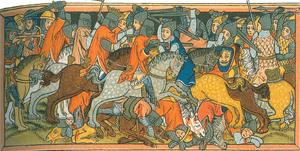Battle of Siirsüüsz: Difference between revisions
Jump to navigation
Jump to search
Content added Content deleted
No edit summary |
mNo edit summary |
||
| Line 33: | Line 33: | ||
The '''Battle of Siirsüüsz''' was fought in mid 3495 CY between the forces of Count [[Kachüül the Brave|Sedüün Kachüül]] and X [[Gazeuri Kaen|Gāzeuri Kaēn]] during the [[Wars of the Birthright]]. The battle was a Küüztschüüsch victory, where the forces of Kachüül defeated a force of over double their size near the village of [[Siirsüüsz]]. The battle is one of the most famous in Gintem history, and is frequently romanticized by Küüztschüüsch nationalists. |
The '''Battle of Siirsüüsz''' was fought in mid 3495 CY between the forces of Count [[Kachüül the Brave|Sedüün Kachüül]] and X [[Gazeuri Kaen|Gāzeuri Kaēn]] during the [[Wars of the Birthright]]. The battle was a Küüztschüüsch victory, where the forces of Kachüül defeated a force of over double their size near the village of [[Siirsüüsz]]. The battle is one of the most famous in Gintem history, and is frequently romanticized by Küüztschüüsch nationalists. |
||
| + | |||
| + | [[Category:Military conflicts]] |
||
Revision as of 09:13, 5 September 2023
| Battle of Siirsüüsz | |||||||
|---|---|---|---|---|---|---|---|
| Part of Wars of the Birthright | |||||||
 A late 36th century depiction of the fighting at Siirsüüsz | |||||||
| |||||||
| Belligerents | |||||||
|
Defenders County of Küüztschüüsches |
Attackers Empire of Vahtyas | ||||||
| Commanders and leaders | |||||||
| Kachüül the Brave | Gāzeuri Kaēn | ||||||
| Strength | |||||||
| Est. 5500 | Est. 12000 | ||||||
| Casualties and losses | |||||||
| ~1500 | ~2500 | ||||||
The Battle of Siirsüüsz was fought in mid 3495 CY between the forces of Count Sedüün Kachüül and X Gāzeuri Kaēn during the Wars of the Birthright. The battle was a Küüztschüüsch victory, where the forces of Kachüül defeated a force of over double their size near the village of Siirsüüsz. The battle is one of the most famous in Gintem history, and is frequently romanticized by Küüztschüüsch nationalists.